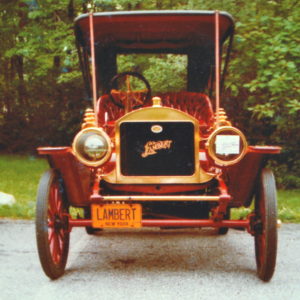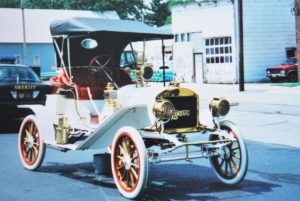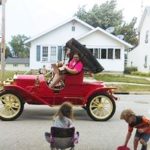More links, lots of information
https://en.wikipedia.org/wiki/Buckeye_gasoline_buggy#History
Buckeye gasoline buggy

The Buckeye gasoline buggy or Lambert gasoline buggy was the first practical gasoline automobile available for sale in America,[1] according to automobile historians.[2]
http://www.american-automobiles.com/Lambert.html
The Lambert Automobile & The Buckeye Mfg. Co.
| Lambert The Buckeye Mfg. Co. Anderson, IN 1905-1917 John W. Lambert made a three wheel car in Ohio City, Ohio in 1891, which is generally considered to be the first gasoline powered American Automobile. In 1893 John Lambert, his brother and father began building stationary gas engines under the Buckeye Mfg. Co. name and later the Lambert Gas & Gasoline Engine Company with factories first in Union City, Ohio then in Anderson, Indiana. |
His automobile interest was jump started in 1902 when he formed The Union Automobile Co. in Union, IN. Lambert produced the Union automobile there from 1902 to 1905. In 1905 production moved to Anderson where it gave way to new models carrying Lamberts own name. The first Lambert automobile was sold June 1, 1905. In 1906 a wide variety of chain driven automobiles were made, all with a Friction Drive.

1906 Lambert Touring Car
Shown above is a 1906 Lambert five passenger Touring Car. In addition The Buckeye Mfg. Co. produced Pleasure Cars, Runabouts and Commercial Trucks. Features included a 98 inch wheel base, 56 inch width, 34 inch x 4 1/2 inch wheels and tires and weighted 2200 pounds.

1910 Lambert Magazine Ad
In the above 1910 magazine ad the Lambert was featured as “The Car of a Thousand Speeds” The ad referred to the unusual friction drive and dual chain drive on all the Lambert automobiles. Five models were produced in 1910 with the five passenger Touring Car priced at $1200.00. Lambert models 99-B and 99-C were equipped with a four cylinder 35 horsepower Rutenber engine.
 1906 Lambert Model A Runabout |
 1909 Lambert Model B2 Touring Car |
Shown below is a 1909 Lambert Model 30 Touring Car equipped with a four cylinder engine rated at 28-30 horsepower, had a 110 inch wheel base and was priced at $1250.00. A second Lambert Touring Car produced in 1909 had a double cylinder engine rated at 18-24 horsepower, had a 94 inch wheelbase and it was priced at $800.00.

1909 Lambert Model 30 Touring Car
|
|










